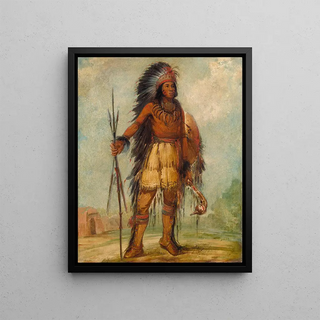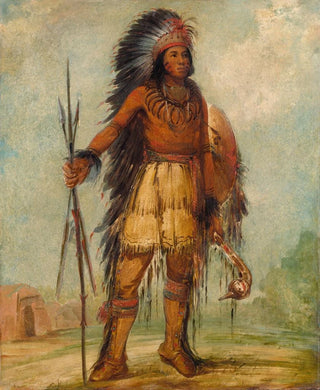Art print | A-Wun-Ne-Wa-Be Thunder Bird - George Catlin


View from behind

Frame (optional)
In the fascinating universe of art, some works transcend the simple frame to become windows into cultures, stories, and emotions. The art print A-Wun-Ne-Wa-Be Thunder Bird - George Catlin is a perfect example. This iconic piece, which captures the essence of a mythical character dear to Native American peoples, evokes both the majesty of nature and the spiritual depth of its subjects. Through this work, Catlin invites us to explore a world where the thunder bird, a central figure in legends, embodies the power and beauty of the human spirit. Contemplating this creation, the viewer is transported to the heart of a rich and vibrant tradition, where each brushstroke seems to whisper stories of a glorious past.
Style and uniqueness of the work
George Catlin's style is distinguished by his attention to detail and his ability to capture the life of Indigenous peoples of America with rare authenticity. In A-Wun-Ne-Wa-Be Thunder Bird, the vibrant colors and dynamic shapes intertwine to give life to a lively scene loaded with meaning. Catlin uses painting techniques that highlight the textures and nuances of feathers, skies, and landscapes, creating an immersive atmosphere. Every element of the composition, from the majestic posture of the bird to the depth of stormy skies, evokes a dramatic tension that draws the eye and captivates the mind. This painting is not limited to a simple representation; it is an invitation to feel the strength and spirituality emanating from this mythical bird, a symbol of connection between the sky and the earth.
The artist and his influence
George Catlin, 19th-century artist and explorer, dedicated his life to documenting Native American cultures at a time when they were threatened by colonial expansion. His work goes far beyond simple illustration; it is a valuable testimony of the cultural diversity and traditions of the peoples he encountered. Catlin was able to capture not only the physical appearance of his subjects but also their soul, their history, and their spirituality. As a pioneer

Matte finish

View from behind

Frame (optional)
In the fascinating universe of art, some works transcend the simple frame to become windows into cultures, stories, and emotions. The art print A-Wun-Ne-Wa-Be Thunder Bird - George Catlin is a perfect example. This iconic piece, which captures the essence of a mythical character dear to Native American peoples, evokes both the majesty of nature and the spiritual depth of its subjects. Through this work, Catlin invites us to explore a world where the thunder bird, a central figure in legends, embodies the power and beauty of the human spirit. Contemplating this creation, the viewer is transported to the heart of a rich and vibrant tradition, where each brushstroke seems to whisper stories of a glorious past.
Style and uniqueness of the work
George Catlin's style is distinguished by his attention to detail and his ability to capture the life of Indigenous peoples of America with rare authenticity. In A-Wun-Ne-Wa-Be Thunder Bird, the vibrant colors and dynamic shapes intertwine to give life to a lively scene loaded with meaning. Catlin uses painting techniques that highlight the textures and nuances of feathers, skies, and landscapes, creating an immersive atmosphere. Every element of the composition, from the majestic posture of the bird to the depth of stormy skies, evokes a dramatic tension that draws the eye and captivates the mind. This painting is not limited to a simple representation; it is an invitation to feel the strength and spirituality emanating from this mythical bird, a symbol of connection between the sky and the earth.
The artist and his influence
George Catlin, 19th-century artist and explorer, dedicated his life to documenting Native American cultures at a time when they were threatened by colonial expansion. His work goes far beyond simple illustration; it is a valuable testimony of the cultural diversity and traditions of the peoples he encountered. Catlin was able to capture not only the physical appearance of his subjects but also their soul, their history, and their spirituality. As a pioneer






